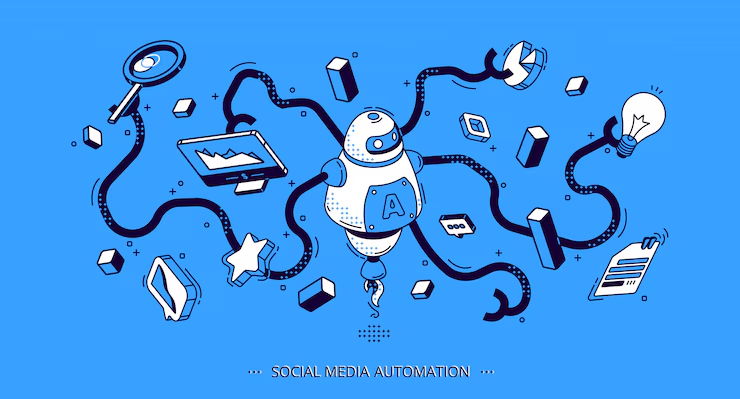Do you find it overwhelming to cut through the immense hype surrounding artificial intelligence to find real, strategic value? You’ve likely encountered a common paradox: a desire to innovate with AI, yet a fear of complex deployments and uncertain returns.
This isn’t just an internal conflict; it’s a market-wide challenge. A Deloitte study found that while 74% of executives are optimistic about their AI projects, a large portion of companies still struggle with adoption and seeing a return on investment within the first year.
In this guide, we move past the abstract and provide a clear, actionable blueprint for implementing enterprise artificial intelligence (AI). We’ll focus on a human-centered approach that drives not just technical success, but quantifiable business outcomes.
Key Takeaways
- Beyond the Hype: Enterprise AI is a strategic system built on a 5-step framework, not an off-the-shelf tool.
- Data is Foundational: The success of any AI project hinges on having high-quality, governed data, not just a large volume of it.
- People and Process Matter: The biggest hurdles are often not technical, but organizational, like internal resistance, skills gaps, and a lack of governance.
- ROI is Quantifiable: Success is measured through pre-defined KPIs, proving the solution’s business value beyond a simple proof-of-concept.
- The Future is Autonomous: Emerging trends like Agentic AI will move beyond simple automation to create intelligent, self-directed systems that handle complex tasks.
Understanding Enterprise AI
While consumer-facing AI tools have brought immense convenience to our daily lives, enterprise AI is a fundamentally different discipline. It is the application of artificial intelligence technologies, such as machine learning, natural language processing, and advanced analytics, to address high-value, complex business challenges at scale.
Unlike personal assistants that handle generalized tasks, enterprise AI is purpose-built to integrate deeply with an organization’s proprietary data and mission-critical workflows.
The distinction lies in its core purpose: consumer AI enhances personal experience, while enterprise AI is engineered to drive organizational outcomes, improve processes, and deliver business value.
Core Aspects of Enterprise AI
An enterprise AI solution is not a standalone tool but a sophisticated, multi-layered architecture designed for reliability, security, and scalability.
- The Data Layer: This layer is responsible for ingesting, validating, and storing vast volumes of structured and unstructured data from disparate sources like your CRM, ERP, and IoT devices. A solid data layer includes the following components:
- Data Governance: Establishing clear policies for data ownership, quality, and access control.
- Data Integration: Creating uninterrupted pipelines to unify data from across the organization, eliminating silos.
- Data Security: Implementing robust measures to protect sensitive and proprietary information.
- The AI and Machine Learning Layer: This is where the intelligence is built. This layer contains the models that are trained on your organization’s data to perform specific functions, from predictive analytics to natural language processing. For enterprise-grade systems, this is defined by the following features:
- Model Governance: Ensuring models are transparent, explainable, and free from bias.
- Continuous Optimization: Automating the monitoring and retraining of models to ensure they remain accurate and relevant as business needs and data evolve.
- The Application Layer: The most powerful AI is ineffective without a user-friendly interface. This layer serves as the bridge between the complex models and the end-user. It focuses on integrating AI outputs into existing workflows and applications, ensuring the solutions are intuitive and accessible to a wide range of employees, not just data scientists.
Ultimately, an enterprise AI solution is not a single product you purchase off the shelf. It is a strategic system built on a foundation of secure data, sound architecture, and a human-centered design philosophy.
But what tangible value does this framework deliver to your organization?
Benefits of Implementing Enterprise AI
Investing in enterprise AI is not about adopting a new technology; it is about building a dynamic engine for organizational growth and competitive advantage. A successful AI strategy delivers tangible, measurable value that directly impacts your bottom line and transforms how your business operates.
Here’s how implementing enterprise AI benefits your organization:
- Improve Operational Efficiency and Cost Savings: AI automates repetitive, high-volume tasks and helps optimize core business functions, which significantly reduces operational costs. This can be seen in predictive maintenance models that decrease equipment downtime and in advanced supply chain systems that improve demand forecasting to prevent overstocking and costly stockouts.
- Enhance Customer Service and Personalization: Enterprise AI enables organizations to create a more dynamic and responsive customer experience. AI-powered chatbots provide instant, 24/7 support for routine inquiries, while sentiment analysis tools analyze customer feedback to identify and address issues proactively. Personalization algorithms analyze customer data to deliver highly relevant product recommendations and customized messages, which increases satisfaction and loyalty.
- Facilitate Data-Driven Decision-Making: AI systems process and analyze vast quantities of data in real-time, uncovering hidden patterns and providing a depth of insight that supports agile and informed decision-making. With Explainable AI (XAI), the rationale behind these insights is transparent, which builds trust and confidence in the system’s recommendations for various strategic choices.
- Drive Innovations in Product and Service Offerings: AI is being used as a means for creating entirely new products and services, not just improving existing ones. Generative design tools can produce new product concepts based on design constraints, while AI-powered market analysis identifies emerging customer needs. This allows companies to accelerate development cycles and bring novel, data-backed offerings to the market faster.
You’ve seen the potential. But how do you create a plan to turn that potential into reality?
Many great ideas get lost in the overwhelming complexities of planning. Codewave’s AI Strategy Consultation service is designed to give you a clear vision, define your KPIs, and provide a custom methodology for success so that you can build with confidence.
Book a consultation with us today!
Achieving these outcomes, however, requires more than just an investment in technology. It demands a clear, step-by-step implementation guide to ensure your AI projects succeed.
5 Key Steps to Implementing Enterprise AI
Translating the strategic value of enterprise AI into a successful, real-world solution requires a methodical and well-defined process. It is a journey that demands a clear roadmap to manage the complexities of data, technology, and user adoption.
Here is a practical, five-phase guide to implementing an enterprise AI solution that delivers tangible outcomes.
Step 1: Strategic Discovery and Opportunity Mapping
Before writing a single line of code, the focus must be on defining the business problem. This phase is about identifying high-impact opportunities where AI can create the most value.
- Conduct a Business Process Audit: Analyze current workflows to pinpoint bottlenecks, inefficiencies, and areas where manual, repetitive tasks are a significant time sink.
- Define Clear Objectives and KPIs: Do not build for the sake of technology. Establish specific, measurable, and achievable goals. For example, the objective might be to “reduce customer support resolution time by 30%” or “improve sales forecasting accuracy by 15%.”
- Assemble a Cross-Functional Team: Bring together a diverse group of stakeholders, including data scientists, subject matter experts from the business unit, IT professionals, and compliance officers. This ensures a holistic view and builds internal buy-in from the start.
- Assess Data Readiness: Evaluate your organization’s data environment. Determine if you have the necessary data to train an AI model, and whether that data is accessible, of sufficient quality, and governed appropriately.
Step 2: Data Foundation and Architecture
AI models are only as good as the data they are trained on. This phase is dedicated to building a reliable, secure, and scalable data foundation that will support the entire AI lifecycle.
- Implement Data Governance: Establish clear policies for data ownership, security, and quality. This ensures that sensitive information is protected and that the data used for training is reliable and unbiased.
- Build Robust Data Pipelines: Create automated data pipelines to ingest, clean, and integrate data from all relevant enterprise systems, such as your CRM, ERP, and internal databases. This ensures a continuous flow of high-quality data to the AI model.
- Design a Scalable Architecture: Determine the optimal infrastructure for your solution, whether it is a cloud-native, on-premises, or hybrid model. The architecture must be designed to scale with your data and user base, ensuring reliable performance under all conditions.
Step 3: Human Centered Design and Prototyping
For an AI solution to be adopted, it must be intuitive and trustworthy. This is where the human element is integrated directly into the development process.
- User Journey Mapping: Map out the exact user experience for the AI solution. This involves understanding how employees will interact with the system and ensuring the interface is logical and fits naturally into their daily workflows.
- Develop UI/UX Mockups: Create visual mockups and interactive prototypes of the interface. This allows for early feedback from end-users, ensuring the design is not just visually appealing but also highly functional.
- Integrate Explainable AI (XAI): The design must include features that provide transparency. For critical decisions, the interface should explain how the AI arrived at its conclusion, building user confidence and trust.
Step 4: Agile Development and Deployment
With a solid plan and a user-centric design, this phase focuses on the iterative development and secure deployment of the AI solution.
- Iterative Development: Utilize an agile methodology to build the solution in manageable sprints. This allows for continuous testing and adaptation based on feedback and new requirements.
- Comprehensive Testing: Conduct rigorous Automation Testing and quality assurance to ensure the solution is reliable, secure, and performs as expected. This includes performance, security, and functional testing.
- Pilot Program Implementation: Before a full-scale launch, deploy the solution to a small, controlled group of users. This pilot program is essential for validating the solution’s real-world performance, collecting feedback, and confirming that the defined KPIs are being met.
Step 5: Governance, Monitoring, and Iteration
Implementation is not the final step; it is the beginning of a cycle of continuous improvement. This phase ensures the long-term success and strategic value of the AI solution.
- Continuous Monitoring: Implement a system to monitor the AI model’s performance in real-time. This helps detect model drift, when a model’s accuracy declines over time, allowing you to retrain it with fresh data.
- Ethical and Compliance Governance: Establish a clear governance framework to oversee the AI system’s use, ensuring it remains compliant with regulations and operates ethically.
- Iterate Based on Feedback: Regularly collect feedback from users and stakeholders. Use this information to inform future iterations and enhancements, ensuring the solution continues to meet evolving business needs.
Following a structured, phased approach is the most effective way to de-risk your investment and ensure your AI initiative moves from a concept to a high-value asset.
Looking for a partner to build your AI vision from the ground up?
Codewave’s AI and ML Development services are built on a foundation of precision and agility. We architect solutions for maximum adaptability, ensuring your AI systems are not only accurate but also scalable and resilient enough to grow with your business.
Contact us today to discuss your AI needs!
While a strategic blueprint provides the “how,” nothing illustrates the potential of enterprise AI better than seeing it in action. Let’s explore how companies are using AI to solve real-world problems today.
Real World Examples: Enterprise AI in Action
The most compelling argument for enterprise AI isn’t a promise of future efficiency, but a case study of present-day results. Many organizations have moved beyond pilots to implement AI solutions that deliver quantifiable outcomes.
Here are a few examples to demonstrate that AI, when applied strategically, is no longer a cost center but a core driver of competitive advantage and measurable business success.
- Fraud Detection
To combat the rising threat of sophisticated fraud, Visa uses AI-powered tools. For instance, its Visa Account Attack Intelligence (VAAI) Score, which uses generative AI to analyze transaction patterns, has helped issuers in the U.S. reduce their false positive rate by 85%, while helping to proactively block $40 billion in fraud in fiscal year 2023.
- Predictive Maintenance
BMW uses an in-house machine learning model to analyze data from its production plants to predict and prevent machine failures. This has resulted in a tangible impact on its operations, saving over 500 minutes of production disruption per plant annually by identifying potential issues before they cause costly downtime.
- Customer Service Automation
Walmart has integrated AI into its customer service and operational workflows to provide faster, more efficient support. Its AI-powered “super agents” can handle complex, multi-step tasks, and it has been shown to reduce customer support resolution times by up to 40%. This enables the company to handle millions of customer queries daily, which frees up its human associates to focus on more creative problem-solving and in-store customer engagement.
- Logistics and Supply Chain Management
UPS uses its AI-driven route optimization software, ORION (On-Road Integrated Optimization and Navigation), to solve one of the most complex logistical challenges: optimizing delivery routes in real time.
ORION has been a game-changer, helping the company save up to 100 million miles of driving annually and resulting in $300 to $400 million in cost avoidance. This also provides a significant environmental benefit by reducing CO2 emissions by approximately 100,000 metric tons per year.
- Sales Forecasting and Strategy
Salesforce’s Einstein AI helps sales teams forecast with greater accuracy. By analyzing historical data, sales activities, and pipeline trends, its predictive models reduce the need for manual estimations. Companies that use AI-driven forecasting can achieve up to 79% accuracy and see a 20% reduction in forecasting errors, leading to more confident business decisions and stronger revenue growth.
However, the path to these outcomes is rarely straightforward. Behind every success story is a complex journey filled with technical hurdles, human considerations, and strategic decisions that can make or break a project.
Common Challenges in Enterprise AI
For every measurable benefit that enterprise AI presents, there exists a corresponding set of strategic challenges that must be proactively managed. The shift from an AI pilot to a full-scale, production-grade solution is where most organizations encounter significant friction.
Acknowledging and preparing for these hurdles helps build a resilient and effective AI strategy.
- Data Integrity, Privacy, and Compliance: The effectiveness of any AI solution depends entirely on the quality and integrity of your data. Many enterprises contend with inconsistent, poorly structured data and disparate data silos that impede model accuracy. Simultaneously, the use of sensitive data raises critical concerns around privacy and compliance with regulations such as GDPR and HIPAA.
- Solution: Establish a robust data governance framework from the outset. This includes implementing clear policies for data quality, security protocols, and audit trails to ensure all data practices adhere to regulatory standards.
- Organizational and People Challenges: The human factor is often the most significant barrier to AI adoption. Projects can face resistance from employees concerned about job security or a lack of understanding. A persistent AI skills gap within the organization also hinders the ability to build and maintain sophisticated solutions.
- Solution: Foster a culture of continuous learning and upskilling. Implement a clear internal communication strategy that positions AI as an augmentative tool, not a replacement. Build a cross-functional team with a mix of technical experts and business domain specialists to ensure alignment.
- Technical Integration and Scalability: Enterprise AI must operate within a complex ecosystem of existing systems. This leads to integration challenges with legacy technologies and can result in significant technical debt. Furthermore, a solution that works for a small pilot may fail to scale reliably to meet enterprise-wide demand.
- Solution: Prioritize a modular and flexible architecture that can be integrated via APIs. Design for scale from the beginning by planning for cloud infrastructure and utilizing robust automation and QA testing to ensure the solution performs reliably under increasing workloads.
- Ethical Considerations and Oversight: AI models, particularly complex ones, can unintentionally perpetuate and amplify biases present in their training data, leading to unfair outcomes. The “black box” nature of some models makes it difficult to explain how a decision was reached, which is a major concern for accountability and trust.
- Solution: Implement a continuous oversight model. This involves integrating Explainable AI (XAI) principles into the design phase and establishing an internal ethics committee or governance body to regularly audit models for bias, fairness, and transparency.
Feeling the pressure of high costs and project risks?
Codewave’s AI Prototype Development service is designed to de-risk your project. In as little as a few weeks, we help you validate your AI concept with a tangible, working prototype, giving you the clarity and stakeholder buy-in you need before committing to a larger investment.
Book a consultation to validate your AI idea!
With a clear understanding of its potential obstacles, we can now turn our attention to what’s next. A new generation of AI is already on the horizon, and it’s set to change the way we work all over again.
Future Trends Shaping Enterprise AI
The foundational work of building and deploying enterprise AI is just the beginning. The next wave of innovation is already here, and it promises to move AI from a tool of automation to a core driver of new business models. This forward-looking perspective is crucial for any enterprise leader aiming to maintain a competitive edge.
- Agentic AI: This trend focuses on autonomous AI systems that can pursue long-term goals without continuous human instruction. These AI “agents” break down complex objectives into smaller tasks, collaborate with other systems, and make independent decisions to achieve a desired outcome. For enterprises, this drives unprecedented levels of efficiency by handling complex, decision-intensive processes, freeing human experts to focus on nuanced, high-value cases.
- Multimodal Generative AI: Generative AI is moving beyond text and images to a multimodal capability, where it can understand and create content by combining multiple data types. This enables the AI to reason across modalities, such as analyzing an image, reading text from it, and generating a descriptive summary. Enterprises are using this to accelerate creative processes in marketing and product design.
- Edge AI: The future of AI is decentralized. Edge AI processes data on devices close to its source, rather than sending it all to a central cloud. This enables real-time decision-making with ultra-low latency, which is crucial for autonomous systems in manufacturing and logistics. For enterprises, this approach also enhances data security and compliance, as sensitive information remains on-device, minimizing the risk of a breach and helping organizations meet strict data privacy regulations.
- Explainable AI (XAI): As AI becomes integral to critical business decisions, from loan approvals to medical diagnostics, its transparency is no longer optional. For enterprises, XAI builds profound trust with customers and regulators by making AI’s decisions understandable and interpretable. It also allows internal teams to debug models more effectively, identify and mitigate hidden biases, and ensure the AI’s logic aligns with business goals, which is crucial for regulatory compliance.
Understanding of these trends is crucial, but the real challenge lies in translating this knowledge into a practical, value-driven solution. Behind every successful AI project is a team with the expertise to turn vision into reality.
Partner with Codewave for Enterprise AI Development
You might begin your AI journey with a clear vision, only to face the common pain point of seeing great ideas get stalled by technical hurdles and implementation complexities. The challenge isn’t a lack of ideas, but a lack of a proven, human-centric approach to turning those ideas into tangible, outcome-driven solutions that enhance your business.
This is where we come in. At Codewave, we specialize in helping businesses overcome this gap. We are more than a development team; we are your strategic partner, guiding you through a process that aligns your business goals with the power of AI. Our approach is to build solutions that are purposeful, empathetic, and designed to deliver visible impact.
Here’s how our AI development services help you:
- Implement Conversational AI: Create virtual assistants and chatbots that offer instant, 24/7 customer support and engagement.
- Utilize Predictive Modeling: Use past data to forecast future trends and make informed decisions that drive growth.
- Unlock Text Data with NLP: Turn unstructured text from customer feedback into structured insights for better business decisions.
- Gain Real-Time Insights: Access clear, AI-powered business intelligence to improve efficiency and product value.
- Build Self-Improving Systems: Develop smart systems that learn and adapt over time, ensuring your solution remains effective and relevant.
The best way to understand our capabilities is to see our work. We invite you to explore our portfolio to see how we have helped other organizations achieve success.
Ready to transform your vision into reality?
The future of your business isn’t just about adopting AI; it’s about building a thoughtful, responsible, and impactful AI strategy. If you’re ready to move from planning to execution, we’re ready to help.
Contact us today to begin your AI journey.
FAQs
1. What is the primary difference between enterprise AI and consumer AI?
While consumer AI, like a virtual assistant, is designed for a broad audience and focuses on general tasks, enterprise AI is purpose-built to solve specific business problems. It integrates deeply with a company’s proprietary data and workflows to drive organizational outcomes, such as improving efficiency, reducing costs, and enhancing strategic decision-making.
2. How do you measure the success or ROI of an AI project?
Measuring success starts in the strategic discovery phase by defining clear, quantifiable KPIs (Key Performance Indicators) before any development begins. ROI can be measured through financial metrics like cost reduction and revenue growth, as well as non-financial metrics such as improved operational efficiency, enhanced customer satisfaction, and increased employee productivity.
3. What are the most common reasons why enterprise AI projects fail?
The majority of AI projects fail due to a lack of strategic planning and foundational issues. The most common reasons include poor data quality, an inability to integrate the solution with existing legacy systems, a lack of alignment from executive leadership, and internal resistance to new workflows.
4. Do we need a large team of data scientists to get started?
Not necessarily. While a skilled technical team is essential, a successful enterprise AI project requires a cross-functional team. This team should include business domain experts to define the problem, IT professionals to manage infrastructure, and project managers to ensure alignment and adoption. A focus on upskilling existing talent and building a culture that embraces AI is often more critical than the sheer size of the data science team.
5. What is a good first step to take when considering AI for my business?
A good first step is a strategic discovery or vision alignment workshop. This involves a structured process of auditing your current business operations to identify specific, high-impact opportunities where AI can solve a clear problem and deliver measurable value. This ensures you start with a purposeful, outcome-driven approach rather than simply investing in a technology.
Codewave is a UX first design thinking & digital transformation services company, designing & engineering innovative mobile apps, cloud, & edge solutions.







